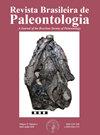First record of plant macrofossil from the Boa Vista Formation, Takutu Basin, Roraima State, Brazil
IF 0.6
4区 地球科学
Q4 PALEONTOLOGY
引用次数: 1
Abstract
Clayey intraclasts containing leaves preserved as impressions and compressions were collected from the Takutu River channel in the State of Roraima, Brazil. In the present study, 23 leaf fragments are described (morphologically and anatomically) and their taxonomic identity is proposed. These fossiliferous intraclasts were suggested in previous studies as coming from the Boa Vista Formation (Upper Pleistocene–Holocene). With the aim of finding new evidence to support this correlation, X-ray diffractometry (XRD) and Laser induced-breakdown spectroscopy (LIBS) analysis were performed, comparing the fossiliferous sample with two outcrops from the Boa Vista Formation. The results evidenced the chemical and mineralogical similarity between the fossiliferous intraclasts and both outcrops, suggesting their correlation with the Boa Vista Formation. Taxonomically, the specimens were recognized as fossil representatives of Dilleniaceae Salisb., Byrsonima Rich. ex Kunth (Malpighiaceae), Zanthoxylum L. (Rutaceae), and other six morphotypes. These taxa represent typical elements of the savanna (lavrados) of Roraima. The anatomical-cutillary characters of the mummified leaves indicate the dominance of xeromorphic plants, similar to the predominant woody species in the “lavrado” today, thus suggesting the same climatic-environmental conditions. Keywords: fossil leaves, leaf architecture, cuticular anatomy, angiosperm, Cenozoic.巴西罗赖马州Takutu盆地Boa Vista组植物大化石的首次记录
从巴西罗赖马州的Takutu河河道中收集了含有树叶的粘土内碎屑,这些树叶被保存为印痕和压缩物。在本研究中,描述了23个叶片片段(形态学和解剖学),并提出了它们的分类身份。这些化石碎屑在以前的研究中被认为来自上更新世-全新世的Boa Vista组。为了寻找新的证据来支持这种相关性,进行了x射线衍射(XRD)和激光诱导击穿光谱(LIBS)分析,将化石样品与Boa Vista组的两个露头进行了比较。结果表明,化石内碎屑与两个露头岩在化学和矿物学上具有相似性,表明它们与Boa Vista组具有相关性。在分类学上,这些标本被认为是沙鱼科的化石代表。, Byrsonima Rich。ex Kunth (malpiighiaceae), Zanthoxylum L.(芸香科)等6种形态。这些分类群代表了罗赖马草原(lavrados)的典型元素。木乃伊叶片的解剖-栽培特征表明旱生植物的优势,类似于今天“lavrado”中主要的木本植物,从而表明相同的气候-环境条件。关键词:叶化石,叶结构,角质层解剖,被子植物,新生代
本文章由计算机程序翻译,如有差异,请以英文原文为准。
求助全文
约1分钟内获得全文
求助全文
来源期刊

Revista Brasileira De Paleontologia
PALEONTOLOGY-
CiteScore
1.60
自引率
14.30%
发文量
25
审稿时长
>12 weeks
期刊介绍:
It publishes original contributions on all aspects of Paleontology. Papers are written in English, Spanish, or Portuguese and are reviewed by international experts.
 求助内容:
求助内容: 应助结果提醒方式:
应助结果提醒方式:


